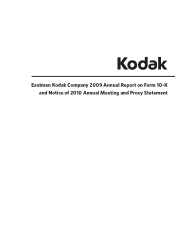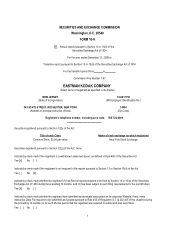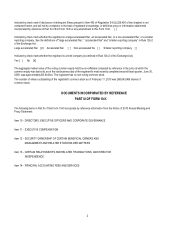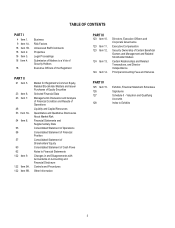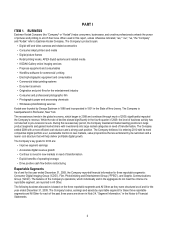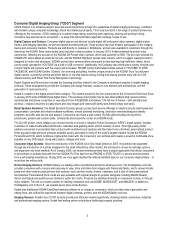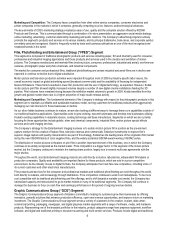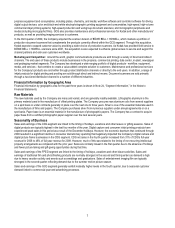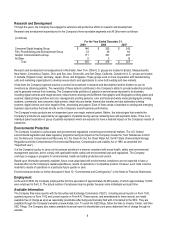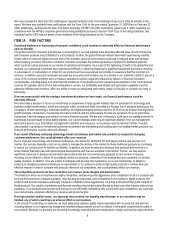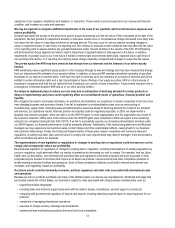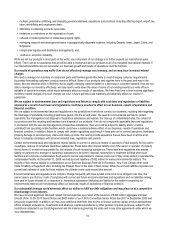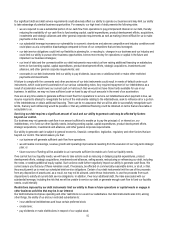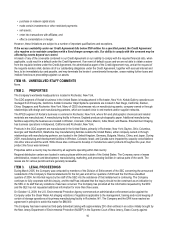Kodak 2009 Annual Report Download - page 8
Download and view the complete annual report
Please find page 8 of the 2009 Kodak annual report below. You can navigate through the pages in the report by either clicking on the pages listed below, or by using the keyword search tool below to find specific information within the annual report. 6
Marketing and Competition: The Company faces competition from other online service companies, consumer electronics and
printer companies in the markets in which it competes, generally competing on price, features, and technological advances.
The key elements of CDG’s marketing strategy emphasize ease of use, quality and the complete solution offered by KODAK
Products and Services. This is communicated through a combination of in-store presentation, an aggressive social media strategy;
online marketing, advertising, customer relationship marketing and public relations. The Company's advertising programs actively
promote the segment’s products and services in its various markets, and its principal trademarks, trade dress, and corporate symbol
are widely used and recognized. Kodak is frequently noted by trade and business publications as one of the most recognized and
respected brands in the world.
Film, Photofinishing and Entertainment Group (“FPEG”) Segment
This segment is composed of traditional photographic products and services including paper, film and chemistry used for consumer,
professional and industrial imaging applications and those products and services used in the creation and exhibition of motion
pictures. The Company manufactures and markets films (motion picture, consumer, professional, industrial and aerial), one-time-use
cameras, photographic paper and photo chemicals, and industrial components.
The market for consumer and professional films, traditional photofinishing and certain industrial and aerial films are in decline and
expected to continue to decline due to digital substitution.
Motion picture and television production activities were impacted throughout most of 2009 by industry-specific labor issues, the
overall economic impact on global advertising spend (broadcast commercials) and the availability of financing for independent
feature filmmakers. These factors resulted in lower film production and the use of digital technology, as expected. However, Kodak
motion picture print film showed slightly increased volumes despite a number of new digital cinema installations feeding the 3D
pipeline. Print volumes have remained strong because the exhibition market returned to growth in 2009. Kodak benefited from this
growth and gained market share due to a higher proportion of major studio release activity.
Marketing and Competition: The fundamental elements of the Company’s strategy with respect to the photographic products in this
segment are to maintain a profitable and sustainable business model, serving customers for traditional products while aggressively
managing our cost structure for those businesses in decline.
As our silver halide business continues to mature, we are also looking at different ways to leverage these core capabilities outside of
our traditional business applications. Opportunities exist to grow existing, nascent businesses and develop new businesses utilizing
Kodak’s existing capabilities in materials science, coating technology and base manufacture. Segments on which we are currently
focusing for these opportunities include gelatin, silver and chemical components, industrial films, motion picture special effects
services and event imaging services.
The Company’s strategy for the Entertainment Imaging business is to sustain motion picture film’s position as the pre-eminent
capture medium for the creation of feature films, television dramas and commercials. Selective investments to improve film’s
superior image capture and quality characteristics are part of this strategy. Kodak has the leading share of the origination film market
led by the new VISION3 family of color negative films, and the widely acclaimed OSCAR-award-winning VISION2 series.
The distribution of motion pictures to theaters on print film is another important element of the business, one in which the Company
continues to be widely recognized as the market leader. Price competition is a bigger factor in this segment of the motion picture
market, but the Company continues to maintain the leading share position, largely due to several multi-year agreements with the
major studios.
Throughout the world, most Entertainment Imaging products are sold directly to studios, laboratories, independent filmmakers or
production companies. Quality and availability are important factors for these products, which are sold in a price-competitive
environment. As the industry moves to digital formats, the Company anticipates that it will face new competitors, including some of
its current customers and other electronics manufacturers.
Film products and services for the consumer and professional markets and traditional photofinishing are sold throughout the world,
both directly to retailers, and increasingly through distributors. Price competition continues to exist in all marketplaces. To be more
cost competitive with its traditional photofinishing and film offerings, and to shift towards a variable cost model, the Company has
rationalized capacity and restructured its go-to-market models in many of its traditional segments. The Company will continue to
manage this business to focus on cash flow and earnings performance in this period of ongoing revenue decline.
Graphic Communications Group (“GCG”) Segment
The Graphic Communications Group segment of Kodak is committed to helping its customers grow their businesses by offering
innovative, powerful solutions that enhance production efficiency, open new revenue opportunities, and improve return on marketing
investment. The Graphic Communications Group segment serves a variety of customers in the creative, in-plant, data center,
commercial printing, packaging, newspaper, and digital prepress market segments with a range of software, media, and hardware
products. Representing one of the broadest portfolios in the industry, product categories range from prepress equipment, workflow
software, and digital and traditional printing to document scanning and multi-vendor services. Products include digital and traditional

